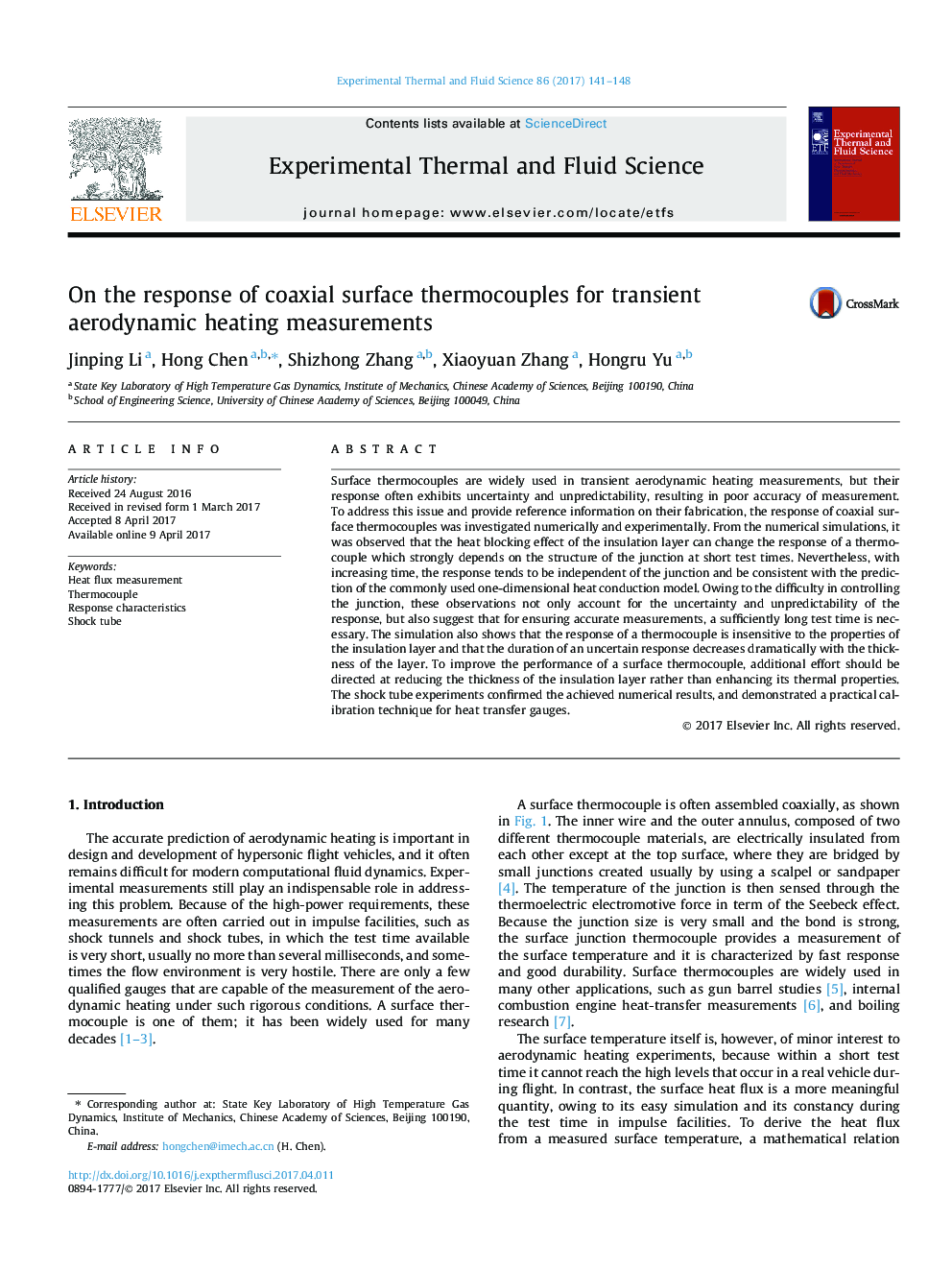| کد مقاله | کد نشریه | سال انتشار | مقاله انگلیسی | نسخه تمام متن |
|---|---|---|---|---|
| 4992492 | 1457390 | 2017 | 8 صفحه PDF | دانلود رایگان |
عنوان انگلیسی مقاله ISI
On the response of coaxial surface thermocouples for transient aerodynamic heating measurements
ترجمه فارسی عنوان
در پاسخ ترموکوپل های سطح کواکسیال برای اندازه گیری های حرارت آیرودینامیکی گذرا
دانلود مقاله + سفارش ترجمه
دانلود مقاله ISI انگلیسی
رایگان برای ایرانیان
کلمات کلیدی
اندازه گیری جریان شار حرارت، ترموکوپل، خصوصیات پاسخ لوله شوک،
ترجمه چکیده
ترموکوپلهای سطحی به طور گسترده ای در اندازه گیری های حرارتی آیرودینامیکی گذرا استفاده می شوند، اما پاسخ آنها غالبا عدم قطعیت و غیر قابل پیش بینی بودن را نشان می دهد و به همین دلیل دقت سنجی ضعیفی دارد. برای پاسخ دادن به این موضوع و ارائه اطلاعات مرجع در مورد ساخت آنها، پاسخ ترموکوپل های سطح کواسیلی به صورت عددی و آزمایشگاهی مورد بررسی قرار گرفت. از شبیه سازی های عددی، مشاهده شد که اثر متوقف کردن گرما از لایه عایق می تواند پاسخ یک ترموکوپل را تغییر دهد که به شدت به ساختار اتصال در زمان آزمایش کوتاه بستگی دارد. با این وجود، با افزایش زمان، واکنش تمایل به مستقل از اتصال دارد و با پیش بینی مدل معمول هدایت حرارت یک بعدی، سازگار است. با توجه به مشکل در کنترل اتصال، این مشاهدات نه تنها به عدم قطعیت و غیر قابل پیش بینی پاسخ می پردازند، بلکه نشان می دهد که برای اطمینان از اندازه گیری های دقیق، زمان آزمون بسیار طولانی لازم است. شبیه سازی نیز نشان می دهد که پاسخ یک ترموکوپل به خواص لایه عایق حساس است و مدت زمان پاسخ نامطلوب به طور چشمگیری با ضخامت لایه کاهش می یابد. برای بهبود عملکرد ترموکوپل سطح، تلاش بیشتر باید در کاهش ضخامت لایه عایق به جای افزایش خواص حرارتی آن انجام شود. آزمایشات شوک لوله نتایج حاصل از عددی را به دست آورد و روش کالیبراسیون عملی برای سنجنده انتقال حرارت را نشان داد.
موضوعات مرتبط
مهندسی و علوم پایه
مهندسی شیمی
جریان سیال و فرایندهای انتقال
چکیده انگلیسی
Surface thermocouples are widely used in transient aerodynamic heating measurements, but their response often exhibits uncertainty and unpredictability, resulting in poor accuracy of measurement. To address this issue and provide reference information on their fabrication, the response of coaxial surface thermocouples was investigated numerically and experimentally. From the numerical simulations, it was observed that the heat blocking effect of the insulation layer can change the response of a thermocouple which strongly depends on the structure of the junction at short test times. Nevertheless, with increasing time, the response tends to be independent of the junction and be consistent with the prediction of the commonly used one-dimensional heat conduction model. Owing to the difficulty in controlling the junction, these observations not only account for the uncertainty and unpredictability of the response, but also suggest that for ensuring accurate measurements, a sufficiently long test time is necessary. The simulation also shows that the response of a thermocouple is insensitive to the properties of the insulation layer and that the duration of an uncertain response decreases dramatically with the thickness of the layer. To improve the performance of a surface thermocouple, additional effort should be directed at reducing the thickness of the insulation layer rather than enhancing its thermal properties. The shock tube experiments confirmed the achieved numerical results, and demonstrated a practical calibration technique for heat transfer gauges.
ناشر
Database: Elsevier - ScienceDirect (ساینس دایرکت)
Journal: Experimental Thermal and Fluid Science - Volume 86, September 2017, Pages 141-148
Journal: Experimental Thermal and Fluid Science - Volume 86, September 2017, Pages 141-148
نویسندگان
Jinping Li, Hong Chen, Shizhong Zhang, Xiaoyuan Zhang, Hongru Yu,
